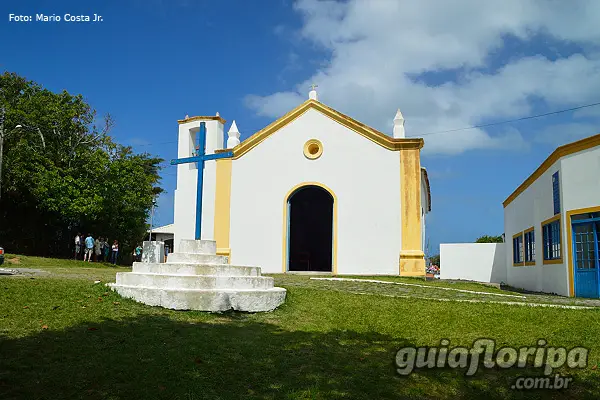The São Sebastião Chapel appears in the archives of the Archdiocese of Florianópolis as "Church of São Sebastião do Rio Tavares", because the seat of this neighborhood was located exactly where the chapel was built. According to oral tradition, it would have been built around 1826, by a member of a wealthy family in the locality. Today, many call it Igrejinha do Campeche .

With simple and quite unpretentious architectural features, its importance derives from the remarkable implementation of the elements that make up the ensemble, such as the nave, with a small sacristy and bell tower, the cemetery and, above all, the small Teatro do Divino, an Azorean tradition. The Teatro do Divino is a small building, with a gabled roof, and an opening surmounted by a lintel in a lowered arch.
Set in a very pleasant place, it has the back (where the cemetery is located) facing the sea, and it is accessed through a path that, at the height of the Teatro do Divino and Cruzeiro, opens into a small wide lawn. .
ADVERTISING
With small dimensions, it has a gabled roof. The original roof was with cape and canal tile, but it was replaced in the renovation in 1974 by French tiles. The main façade has an opening surmounted by a lintel in a lowered arch and an oculus flanked by two massive corners and topped by a cyma, two spires and an iron cross at the apex of the pediment. The bell tower is located to the left of the main facade. The sacristy is on one of the side gables and is the result of a later addition, as well as the cross that stands in front of the chapel. The chapel has several images, of which Santa Catarina stands out, donated in 1922 by the then Archbishop of Florianópolis, D. Joaquim Domingos de Oliveira, and which, according to tradition, would have belonged to the Mother Church of Nossa Senhora do Desterro. Another prominent image is that of São Sebastião, made in the XNUMXth century and which has been significantly altered by successive repaintings.
The entire set, in addition to being considered a Historical, Artistic and Architectural Heritage of the Municipality of Florianópolis, is also protected by Municipal Law nº 2.193 of 1985, which established the Master Plan for the Land Use of the Balneários da Ilha de Santa Catarina, as an Area of Cultural Preservation One (area of historical interest).
Source: Guide to Listed Goods of Santa Catarina



